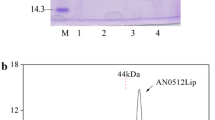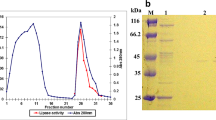Abstract
Cold-active lipase production by the psychrophilic strain Rhodococcus cercidiphylli BZ22 isolated from hydrocarbon-contaminated alpine soil was investigated. Depending on the medium composition, high cell densities were observed at a temperature range of 1–10 °C in Luria–Bertani (LB) broth or 1–30 °C in Reasoner’s 2A (R2A). Maximum enzyme production was achieved at a cultivation temperature of 1–10 °C in LB medium. About 70–80 % of the secreted enzyme was bound to the cell and was highly active as a cell-immobilized lipase which exhibited good reusability; more than 60 % of the initial lipase activity was retained after five-fold reuse. The properties of the lipase produced by the investigated strain were compared with those of a mesophilic porcine pancreatic lipase (PPL). The thermal stability of the cell-immobilized bacterial lipase was higher than that of the extracellular enzyme. Highest activity was detected at 30 °C for the cell-immobilized enzyme and for PPL, while the extracellular enzyme displayed highest activity at 10–20 °C. The bacterial lipase hydrolyzed p-nitrophenyl (p-NP) esters with different acyl chain lengths (C2–C18). The highest hydrolytic activity was obtained with p-NP-butyrate (C4) as substrate, while the highest substrate affinity was obtained with p-NP-dodecanoate (C12) as substrate, indicating a clear preference of the enzyme for medium acyl chain lengths.




Similar content being viewed by others
References
Ahamed A, Vermette P (2008) Culture-based strategies to enhance cellulase enzyme production from Trichoderma reesei RUT-C30 in bioreactor culture conditions. Biochem Eng J 40:399–407
Benjamin S, Pandey A (1998) Candida rugosa lipases: molecular biology and versatility in biotechnology. Yeast 14:1069–1087
Bradford MM (1976) Rapid and sensitive method for the quantitation of microgram quantities of protein utilizing the principle of protein-dye binding. Anal Biochem 72:248–254
Brady D, Jordaan J (2009) Advances in enzyme immobilisation. Biotechnol Lett 31:1639–1650
Clark KJ, Chaplin FW, Harcum SW (2004) Temperature effects on product-quality-related enzymes in batch CHO cell cultures producing recombinant tPA. Biotechnol Prog 20:1888–1892
Feller G, Narinx E, Arpigny JL, Aittaleb M, Baise E, Genicot S, Gerday C (1996) Enzymes from psychrophilic organisms. FEMS Microbiol Rev 18:189–202
Georlette D, Blaise V, Collins T, D’Amico S, Gratia E, Hoyoux A, Marx JC, Sonan G, Feller G, Gerday C (2004) Some like it cold: biocatalysis at low temperatures. FEMS Microbiol Rev 28:25–42
Gerday C, Aittaleb M, Bentahir M, Chessa JP, Claverie P, Collins T, D’Amico S, Dumont J, Garsoux G, Georlette D, Hoyoux A, Lonhienne T, Meuwis MA, Feller G (2000) Cold adapted enzymes: from fundamentals to biotechnology. Trend Biotechnol 18:103–107
Ghosh PK, Saxena RK, Gupta R, Yadav RP, Davidson S (1996) Microbial lipases: production and applications. Sci Prog 79:119–157
Hatzinikolaou DG, Mamma D, Christakopoulos P, Kekos D (2007) Cell bound and extracellular glucose oxidases from Aspergillus niger BTL: evidence for a secondary glycosylation mechanism. Appl Biochem Biotechnol 142:29–43
Houde A, Kademi A, Leblanc D (2004) Lipases and their industrial applications: an overview. Appl Biochem Biotechnol 118:155–170
Huang AHC (1984) Studies on specificity of lipases. In: Borgstrom B, Brockmann HL (eds) Lipases. Elsevier, Amsterdam, pp 419–442
Jaeger KE, Reetz MT (1998) Microbial lipases form versatile tools for biotechnology. Trends Biotechnol 16:396–403
Joseph B, Ramteke PW, Thomas G, Shrivastava N (2007) Standard review cold-active microbial lipases: a versatile tool for industrial applications. Biotechnol Mol Biol Rev 2:39–48
Joseph B, Ramteke PW, Thomas G (2008) Cold active microbial lipases: some hot issues and recent developments. Biotechnol Adv 26:457–470
Kademi A, Danielle L, Ajain H (2005) Lipases. In: Pandey A, Webb C, Soccol CR, Larroche C (eds) Enzyme technology. Asiatech, India, pp 297–318
Kaur P, Singh B, Böer E, Straube N, Piontek M, Satyanarayana T, Kunze G (2010) Pphy—a cell-bound phytase from the yeast Pichia anomala: molecular cloning of the gene PPHY and characterization of the recombinant enzyme. J Biotechnol 149:8–15
Lineweaver H, Burk D (1934) The determination of enzyme dissociation constants. J Am Chem Soc 56:658–666
Mercier C, Frantz BM, Whelan WJ (1972) An improved purification of cell-bound pullulanase from Aerobacter aerogenes. Eur J Biochem 26:1–9
Margesin R, Feller G (2010) Biotechnological applications of psychrophiles. Environ Technol 31:835–844
Margesin R, Zimmerbauer A, Schinner F (1999) Soil lipase activity – a useful indicator of oil biodegradation. Biotechnol Tech 13:859–863
Margesin R, Feller G, Gerday C, Rusell N (2002) Cold-adapted microorganisms: adaptation strategies and biotechnological potential. In: Bitton G (ed) The encyclopedia of environmental microbiology. Wiley, New York, pp 871–885
Margesin R, Hämmerle M, Tscherko D (2007) Microbial activity and community composition during bioremediation of diesel-oil-contaminated soil: effects of hydrocarbon concentration, fertilizers and incubation time. Microbial Ecol 53:259–269
Margesin R, Schinner F, Marx JC, Gerday C (2008) Psychrophiles: from biodiversity to biotechnology. Springer, Berlin Heidelberg, p 462
Margesin R, Moertelmaier C, Mair J (2013) Low-temperature biodegradation of petroleum hydrocarbons (n-alkanes, phenol, anthracene, pyrene) by four actinobacterial strains. Int Biodeter Biodegr 84:185–191
Matsumoto M, Kida K, Kondo K (2001) Enhanced activities of lipase pretreated with organic solvents. J Chem Technol Biotechnol 76:1070–1073
Noel M, Combes D (2003) Effects of temperature and pressure on Rhizomucor miehei lipase stability. J Biotechnol 102:23–32
Pandey A, Benjamin S, Soccol CR, Nigam P, Krieger N, Soccol V (1999) The realm of microbial lipases in biotechnology. Biotechnol Appl Biochem 29:119–131
Seo S, Lee Y-S, Yoon S-H, Kim S-J, Cho J-Y, Hahn B-S, Koo B-S, Lee C-M (2014) Characterization of a novel cold-active esterase isolated from swamp sediment metagenome. World J Microbiol Biotechnol 30:879–886
Struvay C, Feller G (2012) Optimization to low temperature activity in psychrophilic enzymes. Int J Mol Sci 13:11643–11665
Tutino ML, di Prisco G, Marino G, de Pascale D (2009) Cold-adapted esterases and lipases: from fundamentals to application. Protein Pept Lett 16:1172–1180
Tutino ML, Parrilli E, de Santi C, Giuliani M, Marino G, de Pascale D (2010) Cold-adapted esterases and lipases: a biodiversity still under-exploited. Curr Chem Biol 4:74–83
Voigt B, Schweder T, Sibbald MJ, Albrecht D, Ehrenreich A, Bernhardt J, Feesche J, Maurer KH, Gottschalk G, van Dijl JM, Hecker M (2006) The extracellular proteome of Bacillus licheniformis grown in different media and under different nutrient starvation conditions. Proteomics 6:268–281, Erratum in: Proteomics 6:1704–1705
Yu DH, Wang Z, Chen P, Jin L, Cheng YM, Zhou JG, Cao SG (2007) Microwave-assisted resolution of (R,S)-2-octanol by enzymatic transesterification. J Mol Catal B Enzym 48:51–57
Acknowledgments
The authors gratefully acknowledge financial support from the Austrian Academic Exchange Service (OEAD) in charge of the administration of the Eurasia-Pacific Uninet scholarship, National Natural Science Foundation of China (No. 31100574) and Fund from Science and Technology Department of Jilin Province (No. 20110407).
Author information
Authors and Affiliations
Corresponding author
Rights and permissions
About this article
Cite this article
Yu, D., Margesin, R. Partial characterization of a crude cold-active lipase from Rhodococcus cercidiphylli BZ22. Folia Microbiol 59, 439–445 (2014). https://doi.org/10.1007/s12223-014-0318-2
Received:
Accepted:
Published:
Issue Date:
DOI: https://doi.org/10.1007/s12223-014-0318-2




